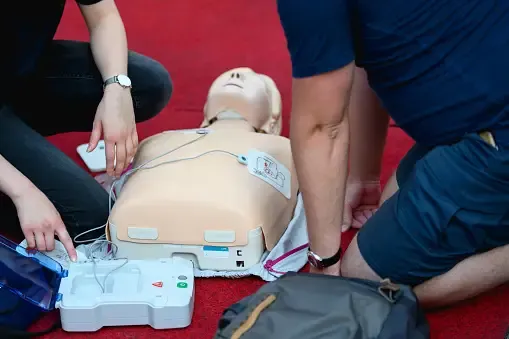
OBTENIR UN DEVIS
First Aid Treatment for Shock
If you're at the scene of an accident, and someone is in shock. What should you do? In this blog post, we'll break down the essential first aid steps for treating shock in simple terms that anyone can understand.
What Does Shock Mean?
Shock occurs when the body doesn't get enough oxygen to its tissues, often due to a drop in blood volume or pressure. It happens when there isn't sufficient blood circulating in the body. When the body's circulatory system malfunctions, the tissues, including the heart and brain, struggle to receive enough oxygen. In response, the body reduces blood flow to the skin, resulting in paleness, coldness, and clamminess. The heart speeds up to compensate, diverting blood away from the gut and causing the person to feel sick and thirsty. Feeling anxious, dizzy, and confused may accompany the lack of oxygen in the brain.
While there are various types and causes of shock, the initial first aid response is generally the same.
Shock Symptoms:
At first:
Fast pulse
Pale, cold, and clammy skin
As shock progresses:
Skin may turn grey-blue, lips may have a blue tinge
Weakness and dizziness
Nausea and vomiting
Thirst
Shallow, rapid breathing
Restlessness, potential aggression, a feeling of impending doom
Yawning and gasping for air
In severe cases, unconsciousness and unresponsiveness may occur, and the person may stop breathing.
Steps for Treating Shock
Step 1: Call for Help
Don't play the lone hero. Call 911 or your local emergency number immediately. Professional help is on the way. Stay calm; help is on the horizon.
Step 2: Keep Them Comfortable
While waiting for help, make the person comfortable. Lay them down and elevate their legs slightly. This helps blood flow to the brain and vital organs.
Step 3: Maintain Body Heat
Shock makes the body temperature drop. Cover the person with a blanket or jacket. Keep them warm but not too hot. It's all about balance.
Step 4: Loosen Tight Clothing
Tight clothes restrict blood flow. Loosen belts, ties, or anything snug. The goal is to make things easy for the blood to circulate.
Step 5: Be a Reassuring Presence
Shock is scary, but your presence matters. Talk to the person in a calm, soothing voice. Reassure them that help is on the way. Sometimes, a little comfort goes a long way.
Step 6: Don't Offer Food or Drink
The last thing a person in shock needs is food or drink. It might make things worse. Stick to the basics—waiting for professional help.
Step 7: Monitor Breathing
Keep an eye on their breathing. If they stop breathing, be ready to perform CPR if you know how. If not, follow the emergency dispatcher's instructions.
Conclusion
Shock is scary, but your actions can make a difference. Remember, call for help, keep the person comfortable, and provide reassurance. First aid isn't about being a superhero; it's about being there until the professionals arrive. Stay calm, act fast, and you could be someone's hero.

